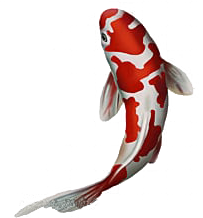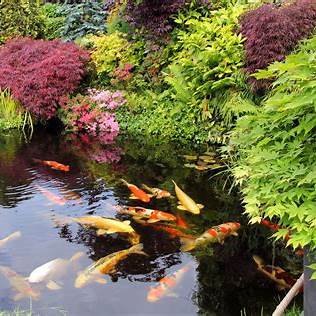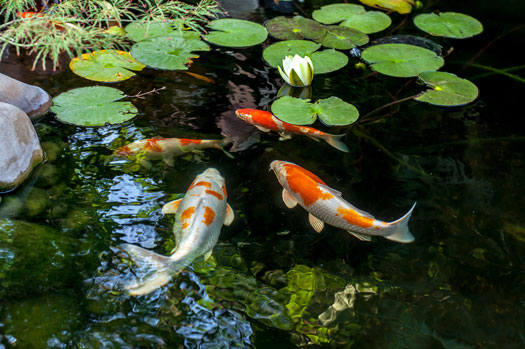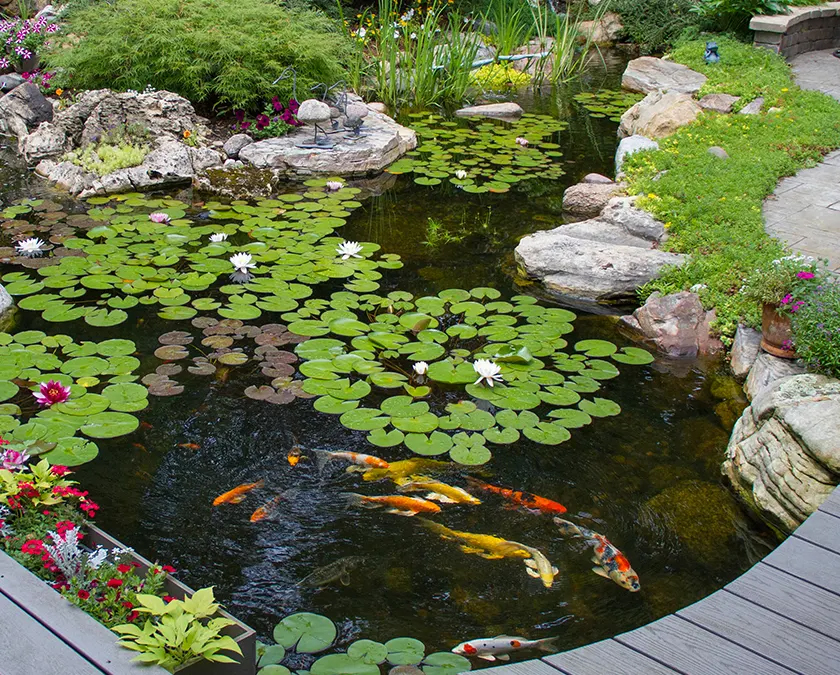KOI FISH
& KOI PONDS
Learn about the facinating KOI FISH and their watery environment!

KOI FISH
Symbols of Strength, Beauty, and Serenity

Graceful and colorful, koi fish are among the most beloved features of Japanese gardens. But did you know their origins date back thousands of years?
Humble Beginnings
Koi are descendants of the common carp (Cyprinus carpio), a freshwater fish originally found in China and Central Asia. As early as 500 BCE, Chinese farmers raised carp in rice paddies. Occasionally, some fish displayed unique colors—red, gold, or white—but they were mainly bred for food.
The Birth of Nishikigoi in Japan
In the early 1800s, farmers in Niigata, Japan, began selectively breeding these colorful carp—not to eat, but to admire. They called them “Nishikigoi”, or “brocaded carp,” for their shimmering patterns. Over generations, these koi became living works of art.
Their popularity spread slowly—until a 1914 exhibition in Tokyo, where koi were shown to the public for the first time. Japan, and soon the world, fell in love.
Koi Go Global
After World War II, koi began appearing in ponds across Europe and America. Today, they’re bred and displayed worldwide, yet Japan remains the spiritual home of koi, with Niigata still known for producing champion fish.
Some koi can live over 50 years and grow up to 3 feet long. The most prized koi are valued not just for their color, but for their grace, balance, and lineage.
Symbols of the Spirit
In Japanese and Chinese culture, koi symbolize:
-
Perseverance (for swimming upstream)
-
Good fortune and success
-
Peace and harmony
Legend tells of a koi that swam up a waterfall and turned into a dragon—a story of strength through persistence.
At Shinzen Friendship Garden, our koi are not just beautiful—they’re part of a long tradition of cross-cultural appreciation, patience, and peace.
symbolism in japanese culture
In Japan, koi fish stand for strength, perseverance, and big dreams, just like in Chinese culture. They are also linked to boys and are an important symbol during Children’s Day (Tango no Sekku). On this holiday, families hang colorful koi-shaped streamers (koinobori) to wish for their children’s health and success.
Symbolism in Japanese Culture
In Japan, koi represent strength, resilience, and ambition, similar to Chinese beliefs. They are also associated with masculinity and are a common motif during Children’s Day (Tango no Sekku), celebrated with colorful koi-shaped streamers called koinobori to wish for children’s health and success.
Each koi color has a specific meaning:
- Gold: Wealth and prosperity.
- Red: Love and courage.
- Black: Overcoming adversity.
- White: Success and transformation.
SOURCES
-
Balon, E.K. (1995). Origin and domestication of the wild carp. Aquaculture.
-
Simpson, A. (2005). Koi: A Complete Guide to Their Care and Color Varieties.
-
CNN Travel (2018). A koi fish just sold for $1.8 million.
-
Niigata Koi Breeders Association, Japan.


KOI PONDS

Cultural Significance of KOI PONDS
The koi pond has deep cultural and historical significance in both Chinese and Japanese traditions, symbolizing prosperity, perseverance, and tranquility. Its origins and meanings have evolved over time, shaped by mythologies, philosophies, and aesthetic principles. Here’s a detailed look at its history:
Chinese Roots – Origins in Chinese Mythology
The concept of the koi fish is deeply rooted in Chinese folklore. One of the most famous stories is the Dragon Gate Legend, which tells of koi swimming upstream in the Yellow River and attempting to leap over a powerful waterfall called the Dragon Gate. Those that succeeded were transformed into powerful dragons, symbolizing strength, determination, and success against all odds.
- This myth is often interpreted as an allegory for personal ambition and overcoming obstacles.
Symbolism in Chinese Culture
Koi fish are associated with wealth and prosperity, partly because the Chinese word for fish (鱼, yú) sounds like the word for surplus or abundance (余, yú).
Koi are often depicted in art and literature, especially during the Lunar New Year, as they are believed to bring good fortune and blessings.
Koi Ponds in Chinese Philosophy
Koi ponds align with principles of Feng Shui, the Chinese practice of harmonizing individuals with their environment. A well-placed koi pond is believed to channel positive energy (or chi) into a home or garden, promoting health, happiness, and prosperity.
Japanese Influence – Introduction to Japan
Koi were introduced to Japan from China around the 8th century, initially as a food source. Over time, selective breeding began, leading to the development of vibrant, multicolored varieties we recognize today.
Aesthetic and Spiritual Significance
By the Edo period (1603–1868), koi ponds became an essential feature of Japanese gardens, designed to reflect nature’s beauty and provide a space for contemplation and serenity.
Koi are closely associated with the Zen principles of balance, tranquility, and mindfulness, often used in temple gardens to aid meditation.
Artistic Depictions
Koi appear frequently in Japanese woodblock prints and tattoos, symbolizing transformation, endurance, and the pursuit of one’s goals.
Cultural Convergence and Modern – Day Symbolism
While rooted in Chinese mythology and refined through Japanese artistry, koi ponds today are celebrated globally as symbols of peace and prosperity. Both cultures emphasize the importance of koi in representing perseverance, a harmonious connection to nature, and spiritual enlightenment.
Modern koi ponds, whether in private gardens, temples, or public parks, remain an enduring legacy of these ancient traditions, cherished for their aesthetic appeal and deep symbolic resonance.
There are several noteworthy koi ponds around the world that showcase exceptional design, cultural significance, and beauty. These destinations are must-visits for koi enthusiasts or anyone seeking tranquility and inspiration. Here are some of the most remarkable koi ponds globally:
Ritsurin Garden (Takamatsu, Japan)
LINK: https://www.my-kagawa.jp/ritsuringarden
One of Japan’s most famous historical gardens, dating back to the Edo period (17th century).
Features multiple koi ponds surrounded by lush landscapes, traditional teahouses, and arched bridges.
Highlight: The meticulously manicured garden is designed for seasonal beauty, offering stunning views year-round.
Byodo-In Temple (Oahu, Hawaii, USA)
LINK: https://byodo-in.com/
A replica of the 950-year-old Byodo-In Temple in Uji, Japan, this temple is surrounded by breathtaking gardens and a serene koi pond.
Highlight: The pond is home to hundreds of koi, and the setting includes a large Buddha statue and tranquil waterfalls.
Portland Japanese Garden (Portland, Oregon, USA)
LINK: https://japanesegarden.org/
Known as one of the most authentic Japanese gardens outside Japan.
Features koi ponds integrated with traditional Japanese garden elements like stone lanterns, bridges, and streams.
Highlight: The koi pond is a centerpiece of this beautifully serene space.
Adachi Museum of Art (Shimane Prefecture, Japan)
LINK: https://www.adachi-museum.or.jp/gardens
Famous for its fusion of art and nature, the museum’s gardens are ranked among the best in Japan.
The koi pond reflects the surrounding sculpted landscapes, creating a perfect harmony between nature and art.
Highlight: The gardens are best viewed from the museum’s windows, offering a frame-like perspective of the koi pond.
Kew Gardens (London, England)
LINK: https://www.kew.org/
A UNESCO World Heritage Site with an extensive collection of plants, trees, and water features.
Includes a koi pond in the Japanese Garden area.
Highlight: The koi pond is surrounded by traditional Japanese architecture, offering a peaceful retreat within the vibrant garden.
The Huntington Library and Gardens (San Marino, California, USA)
LINK: https://huntington.org/
Features a stunning Japanese garden complete with a koi pond, arched bridges, and stone lanterns.
Highlight: The expansive gardens offer a mix of cultural elements and beautiful koi displays.
Nan Lian Garden (Hong Kong, China)
LINK: https://www.lcsd.gov.hk/en/parks/nlg/index.html
A public park designed in the Tang dynasty style, featuring a koi pond, bonsai trees, and traditional Chinese architecture.
Highlight: The koi pond sits near the iconic Golden Pavilion and red-arched bridge, making it a popular photo spot.
Monte Palace Tropical Garden (Madeira, Portugal)
LINK: https://montepalacemadeira.com/
Located on the volcanic island of Madeira, this garden blends Asian and European influences, with koi ponds scattered throughout the lush landscape.
Highlight: The koi ponds are integrated with waterfalls and surrounded by exotic plants and traditional Asian sculptures.
Hakone Estate and Gardens (Saratoga, California, USA)
LINK: https://www.hakone.com/visitor-info
One of the oldest Japanese-style gardens in the Western Hemisphere, established in 1915.
Features a koi pond surrounded by bamboo gardens and traditional Japanese structures.
Highlight: A peaceful and authentic space for koi and garden lovers alike.
Plan Your Visit
Each koi pond has its unique charm, whether it’s the lush landscapes of Ritsurin Garden or the cultural fusion at Monte Palace Tropical Garden. If you’re planning a trip to any of these locations, take time to enjoy the peace and beauty these koi ponds offer! Let me know if you’d like tips for visiting any of these destinations.
***




